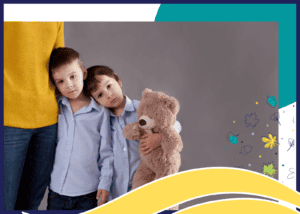Empowering Parents: A Guide to Supportive Parenting for Anxious Childhood Emotions (SPACE) Treatment
Is your child’s anxiety affecting how your family functions? How YOU as the parent operates on a day to day basis? Are you finding yourself changing your own behaviours to help manage your child’s distress. It’s not just you. Parents deeply love and care about their kids, and want to help them in times of distress.
Anxiety disorders are one of the most common mental health issues among children and adolescents. According to Anxiety Canada, upwards of 20% of children and teens are affected. Anxiety disorders can negatively impact children’s daily functioning, academic performance, and relationships with family and peers. Therefore, it is essential to treat them early and effectively to prevent long term effects on children’s mental health.
Supportive Parenting for Anxious Childhood Emotions (SPACE) therapy is an evidence-based treatment approach designed to address anxiety disorders in children by engaging their parents and caregivers as the primary treatment approach. The goal of SPACE is to:
- Help parents into a supportive role
- Restore the young person’s (child’s, but it can be teen or even young adult!) autonomy
- Help improve your child’s self regulation and coping, although indirectly
- Develop a supportive community
- Improve communication (and collaboration!) among family members
- Focus unilaterally on parent’s actions (and not require child’s involvement)
- Minimize escalation, and minimize changes of the problem continuing or getting bigger
Learn more about SPACE from the founder, Eli Lebowitz in his talk, Rethinking Treatment for Child Anxiety and OCD found on YouTube.
Key Insights: Unique Concepts in Child Anxiety Treatment
Here are some important concepts that are unique to this way of treating child anxiety.
- Child anxiety is a systemic and interpersonal phenomenon, because children are meant to live with caring adults that keep them safe and help manage threats.
- Everything that a parent does to help a child avoid anxiety-related distress, which is referred to as parental accommodation, is a natural, biological, and totally normal response to childhood anxiety disorders.
- Parental accommodation can actually have a negative impact on the course of anxiety disorders in childhood and beyond
- Parents can reduce their child’s anxiety indirectly by changing their own behaviour. We cannot change someone else’s behaviour, we can only change our own.
Anxiety disorders can significantly affect a child’s life in various ways, including academic performance, social interaction, physical health, and overall well-being. Since children spend the majority of their time with their families, a child’s anxiety can significantly impact family dynamics. By focusing on parents in the therapeutic process, we can impact long-lasting change not just for the individual child, but for the whole family system.
Introducing SPACE
Supportive Parenting for Anxious Childhood Emotions (SPACE) therapy is an evidence-based treatment approach designed to treat anxiety disorders in children through directly working with the parents. SPACE is based on the idea that parents play a critical role in their child’s ability to manage and regulate their emotions.
SPACE therapy includes five stages
- Setting the Stage: This initial stage involves educating parents about anxiety and its impact on children’s behavior and emotions. An important concept we highlight here is the concept of personal boundaries, and how as parents we are programmed to respond to our chid’s distress, which can lead to parents adapting and changing their behaviours, routines, expectations, and home environment. We then explore the idea of true support, and how parents can support their anxious child.
- Charting Accommodations: The idea of accommodations stems from the fact that in order to respond to the child’s anxiety, parents will do almost anything to help. Part of this help ultimately reduces distress in the short term, such as when a parent speaks for a child in a social situation (like ordering food), sleeping next to a child, participating in rituals in more extreme OCD beahviour, or answering questions related to a child’s persistent worry.
As helpful as this may be to get your family from moment to moment, accommodating anxiety and changing our behaviour as parents actually has the child learn to depend on parents for regulation, and then ultimately maintains symptoms of anxiety.
- Choosing a Target Problem and Informing the Young Person: At this stage, the therapist works with parents to develop effective communication and problem-solving strategies to promote healthy family dynamics and reduce anxiety-inducing behavior patterns. Parents, with the help of a trained therapist, will choose a target problem (one that is significant, recurrent, and accommodation based), and inform the child that there will be changes in a structured and supportive way.
- Formulating a Plan: With the help of the therapist, parents plan out clear changes that parents can do to their own behaviour that is tied to the target problem. By planning out clear expectations, and troubleshooting possible challenges along the way, parents will be equipped to begin supportively challenging the young person’s behaviour and encouraging them to use their own coping skills.
- Reducing Accommodations: Together, parents and therapist focus on implementing the plan, monitoring, and gradually developing the plan to continue reducing accommodating behaviour. The important thing to remember is that parental change is progress, and that parents are demonstrating to the child that they are kind leaders that can set boundaries and trust in the child’s ability to get through moments of distress. Parents can take the lead. And with strong leaders that can keep them safe and trust in their abilities, the child’s symptoms of anxiety can reduce.
In closing, we want to emphasize the pivotal role parents play in supporting their children’s emotional well-being, particularly when it comes to managing anxiety. Through Supportive Parenting for Anxious Childhood Emotions (SPACE) therapy, we are utilizing a structured approach designed to empower parents in navigating their child’s anxiety journey. From understanding the impact of anxiety on behaviour to gradually reducing accommodating behaviours, each stage of SPACE therapy is aimed at fostering a supportive environment where children can thrive. By embracing this process, parents become not only advocates but also compassionate leaders, guiding their children toward healthier coping mechanisms and greater resilience. Remember, as parents, you possess the strength and capacity to lead your family through moments of distress with kindness and confidence. Together, let’s continue to foster an environment where our children feel supported, understood, and equipped to overcome their anxiety challenges.
SPACE at Acorn Counselling
As we grow our Parent Support Team at Acorn Counselling, we have a number of therapists trained in this ground-breaking approach, and are supporting parents individually and through group processes. Our SPACE group is a special place for parents who may feel isolated and guilty about their situation to come together and know that they’re not alone, find support in community, and build their own confidence in their skills to lead and confidence in their child’s ability to cope with distress.
Keep an eye on our newsletter for additional information, or follow us on social media as we share more information and exciting news related to our Parent Support Program, and the events that you can take part in such as free workshops, groups, and so many resources!
To learn more about our group or individual supports, please reach out to us through our Book Now page. We are honoured to support families in building resilience, connection, and coping.





